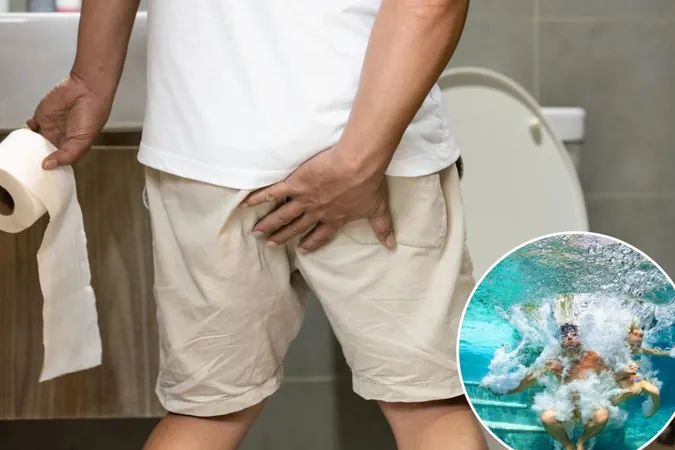
Beware of Pool Water: The Germs Lurking Beneath the Surface
2025-07-24
Author: Jessica Wong
Planning a splashy day at the pool this summer? Hold on — you might be diving into a toxic stew of germs!
Chlorine is often seen as the ultimate germ fighter, but don’t be fooled; it isn't an instant solution. There are persistent, harmful bacteria that can survive in treated water longer than you think, putting your health at serious risk.
In fact, reports of waterborne illnesses linked to pools are on the rise, with one particularly nasty parasite set to ruin your fun with severe diarrhea.
What Lies Beneath the Surface?
That inviting blue water isn't as pristine as it might appear.
Each time someone jumps in, they bring along not just towels and sunscreen but a slew of bacteria, dirt, and bodily fluids that could easily make others ill. According to the CDC, just one swimmer can introduce staggering amounts of microbes into the pool, including:
- 8 million microbes from a single drop of spit
- 140 billion microbes from fecal matter
- Scores of sweat equivalent to two cans
- A surprising cup of urine
These substances mix with chlorine to create chloramines, a byproduct that can irritate your eyes and lungs and gives off that intense chlorinated smell often mistaken for cleanliness.
The Myth of Cleanliness
"It's a common myth that a strong chlorine odor signifies a clean pool," notes Lisa Cuchara, an immunologist. In reality, it could be a warning sign that the water is tainted and best avoided.
The Hidden Dangers of Pool Water
Most pool-related illnesses stem from inadvertently swallowing or coming into contact with contaminated water.
While properly maintained chlorine can kill many germs like E. coli in under a minute, some are tough nuts to crack. For instance, hepatitis A can hang around in a chlorinated pool for up to 16 minutes, often making its way into the water through fecal contamination.
Once you're infected, the virus can lead to liver inflammation and serious health issues.
Then there's giardia, a parasite that can thrive in pools when swimmers neglect to rinse themselves properly. It can resist chlorine for over 45 minutes, and even a tiny sip of tainted water can result in stomach issues.
The Terrifying Truth About Cryptosporidium
The worst offender? Cryptosporidium, a hardy germ that can survive in chlorinated water for up to 10 days.
Often, it spreads when someone with diarrhea contaminates the water, easily infecting other swimmers. Between 2009 and 2017, this parasite was responsible for nearly 450 outbreaks across 40 states, sickening over 7,400 people, and alarming reports reveal that such outbreaks are increasing annually.
"Just a mouthful of water contaminated with crypto can leave otherwise healthy individuals suffering from severe diarrhea and nausea for weeks," warns Michele Hlavsa, chief of the CDC's Healthy Swimming Program.
Watch Out for Other Intruders!
But the dangers don't end there. Other pests like Shigella, norovirus, and adenovirus also lurk in chlorinated pools, ready to wreak havoc on your health.
Added to that, bacteria like Legionella and Pseudomonas can pose serious risks too. Legionella can cause pneumonia, while Pseudomonas is notorious for skin rashes and ear infections.
Even fungi thrive in pool environments. Pool decks and locker rooms are breeding grounds for fungal spores, leading to common infections like athlete’s foot.
Stay Safe This Summer!
But don’t hang up your swimsuit just yet! There are steps you can take to mitigate these risks.
The CDC advises staying out of the water if you’ve had diarrhea and waiting a solid two weeks after symptoms clear before diving back in.
A pre-swim shower for at least a minute can help rinse off sweat and germs.
Parents should take kids on bathroom breaks frequently and check diapers regularly — and please, change them away from the poolside!
Whenever you're in the pool, try to avoid swallowing water, and when you get out, dry your ears thoroughly to fend off swimmer's ear.
And for heaven’s sake, don’t pee or poop in the pool! Seems obvious, right? Not for everyone. Just last year, New York City's parks department had to shut down pools 203 times due to such incidents, with 44 pools affected at least once for what they call a 'code brown.'


 Brasil (PT)
Brasil (PT)
 Canada (EN)
Canada (EN)
 Chile (ES)
Chile (ES)
 Česko (CS)
Česko (CS)
 대한민국 (KO)
대한민국 (KO)
 España (ES)
España (ES)
 France (FR)
France (FR)
 Hong Kong (EN)
Hong Kong (EN)
 Italia (IT)
Italia (IT)
 日本 (JA)
日本 (JA)
 Magyarország (HU)
Magyarország (HU)
 Norge (NO)
Norge (NO)
 Polska (PL)
Polska (PL)
 Schweiz (DE)
Schweiz (DE)
 Singapore (EN)
Singapore (EN)
 Sverige (SV)
Sverige (SV)
 Suomi (FI)
Suomi (FI)
 Türkiye (TR)
Türkiye (TR)
 الإمارات العربية المتحدة (AR)
الإمارات العربية المتحدة (AR)